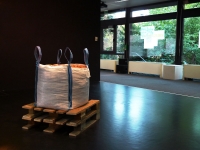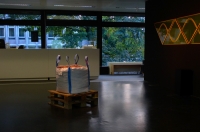1t ct
434,782 eurocents (4347.82 €), big bag, Europool palettes
100 x 100 x 80 cm
2009
The piece “1t ct” (one ton of eurocents) is formally composed of a heavy-duty bulk bag (FIBC or big bag) designed for a weight of one ton that has been filled with one ton of eurocents worth EUR 4,347.82.
FIBC bags (flexible intermediate bulk containers) are used mainly for the processing of bulk materials and can be found across a wide range of industries. On building sites they are filled with either sand or gravel, while farmers employ them for storing grain and forage. Just like these goods, euro coins are industrially mass-produced. However, from among the range of coins only the nominal value of the 1-cent coin reflects its actual manufacturing cost, alongside its material value and weight.
The sculpture is, by its form, suggestive of interpreting money as a construction material and a means that enables creativity. Yet in our imagination we immediately compute the coins’ nominal value, even if it would not be as readily available to us in reality. Only the emitter, namely the Central Bank, is obliged to accept such a large amount of coins; moreover, moving a full ton is a tough job at any rate. In large quantities the form of the coin therefore deactivates the money’s function, placing additional emphasis on its materiality.
The 434,782 cents are a mixture of part new and part circulation coinage. Many of them were issued in other European countries and many show visible signs of wear. Even so, these singularities disappear in the shuffle, merging instead into a shimmering mass. The different shades blend into one single image; they become one color, one structure. Individual coins get lost in the tangle and are thus no longer perceived as such. Items of money are transformed into small copperplates.
Formal besteht die Arbeit "1t ct" (eine Tonne Eurocents) aus einem für das Gewicht von einer Tonne ausgelegten Schwerlast-Transportsack (FIBC oder auch Bigbag) gefüllt mit einer Tonne Eurocents im Gegenwert von 4347,82 Euro.
FIBC-Säcke (Flexible Intermediate Bulk Containers) werden hauptsächlich für die Verarbeitung von Schüttgütern verwendet und sind in vielen Industriezweigen zu finden. Auf Baustellen findet man sie mit Sand oder Kies gefüllt, in der Landwirtschaft lagern darin Korn oder Futtermittel. Genauso wie diese Waren sind auch die Euromünzen industriell gefertigte Massengüter. Von all diesen Münzen spiegelt aber nur die 1 Cent Münze ihren tatsächlichen Herstellungspreis, und somit auch Materialwert und Gewicht, im Nennwert wider.
Durch ihre Form legt die Skulptur eine Sichtweise auf Geld als Baumaterial, als Mittel zum Erschaffen, nahe. In unserer Vorstellung gehen wir dabei sofort mit dem nominellen Wert der Münzen um, der allerdings in der Realität so nicht direkt verfügbar wäre. Nur der Emitter, die Zentralbank, ist verpflichtet Münzen in dieser Menge anzunehmen und eine Tonne lässt sich ohnehin nicht so leicht bewegen. In dieser Menge deaktiviert also die Münzform in gewisser Weise die Funktion des Geldes und unterstreicht somit zusätzlich die Materialität.
Die 434782 Cents bestehen teils aus neuen Münzen und teils aus Umlaufgeld. Viele wurden von anderen europäischen Ländern ausgegeben und viele haben sichtbare Spuren des Gebrauchs. Diese Einzigartigkeiten gehen jedoch in der Menge unter und fügen sich zu einer schillernden Masse zusammen. Die unterschiedlichen Schattierungen fügen sich in ein Bild ein, werden zu einer Farbe, einer Struktur. Die darin enthaltene einzelne Münze verliert sich im Gewirr und entzieht sich damit auch der Warnehmung. Aus den Geldstücken werden Kupferplättchen.
Florian Jenett, 2009




